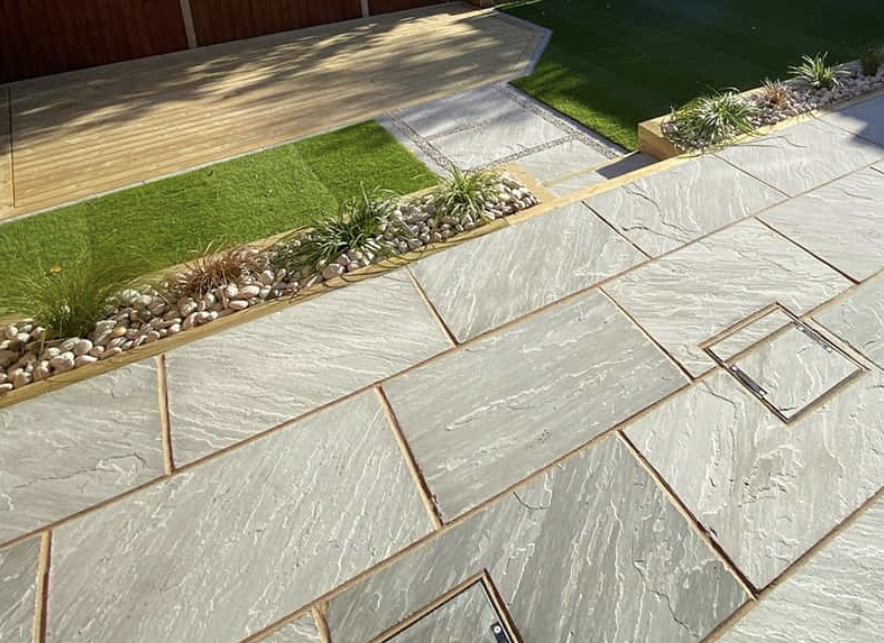
Comparing Porcelain Paving and Indian Stone Patio: Making the Right Choice
Creating a stunning outdoor space often begins with the choice of the right paving material. Two popular options that frequently make their way into the discussion are Porcelain Paving and Indian Stone Patio. Each of these materials brings its own unique characteristics to the table, and understanding the differences can help you make an informed decision for your next landscaping project.
Porcelain Paving: A Modern Marvel
What Is Porcelain Paving?
Porcelain paving is a relatively modern addition to the world of outdoor surfacing materials. It is made from high-quality porcelain clay that is fired at extremely high temperatures, resulting in a dense, durable, and non-porous surface. Porcelain pavers are available in a wide range of colors, textures, and sizes, making them versatile and adaptable for various design schemes.
Advantages of Porcelain Paving
- Durability: Porcelain pavers are exceptionally durable and can withstand heavy foot traffic, making them suitable for high-traffic areas.
- Low Maintenance: They are virtually maintenance-free, as they are resistant to stains, frost, and mold growth.
- Aesthetic Versatility: Porcelain paving offers a vast array of design options, from sleek modern designs to more traditional aesthetics.
- Easy Installation: Porcelain pavers are often thin and lightweight, making installation a relatively straightforward process.
- Eco-Friendly: Some porcelain pavers are made from recycled materials, contributing to a more sustainable choice.

Considerations for Porcelain Paving
- Price: Porcelain paving tends to be more expensive than some other options.
- Slip Resistance: While many porcelain pavers have anti-slip properties, it’s essential to ensure they are suitable for your intended use.
Indian Stone Patio: Timeless Beauty
What Is Indian Stone Patio?
Indian stone, often referred to as natural stone, is a classic choice for outdoor paving. It includes a variety of stone types like sandstone, limestone, and granite, each with its unique characteristics. Indian stone patios are known for their natural beauty, often showcasing rich earthy tones and unique veining.
Advantages of Indian Stone Patio
- Natural Aesthetics: The inherent beauty of Indian stone cannot be replicated, making it an excellent choice for a more traditional or rustic look.
- Diverse Options: Indian stone comes in various types, each with distinct colors and textures, allowing for creative design possibilities.
- Sustainability: It’s a natural product, making it an environmentally friendly choice.
- Longevity: When well-maintained, Indian stone patios can last for generations.
Considerations for Indian Stone Patio
- Maintenance: Indian stone patios may require more maintenance, including sealing, to preserve their appearance.
- Price Variability: The cost of Indian stone can vary depending on the type of stone and its source.
- Porosity: Natural stone is porous, which means it may be prone to staining and damage if not sealed properly.
Making Your Decision
The choice between porcelain paving and an Indian stone patio ultimately comes down to your specific preferences and project requirements. Here are a few key considerations to help you make the right decision:
- Aesthetic Preference: Consider whether you prefer a modern, sleek look (porcelain) or a more natural, rustic appearance (Indian stone).
- Budget: Your budget will play a significant role in your decision-making process.
- Maintenance Tolerance: How much time and effort are you willing to invest in maintaining your outdoor space?
- Durability Needs: Assess the expected foot traffic and usage of the area.
- Environmental Concerns: If sustainability is a priority, consider the eco-friendliness of your choice.
Both porcelain paving and Indian stone patios have their unique charm and advantages. The key is to match your choice to your specific needs and personal taste, ensuring a beautiful and functional outdoor space that suits your lifestyle.








